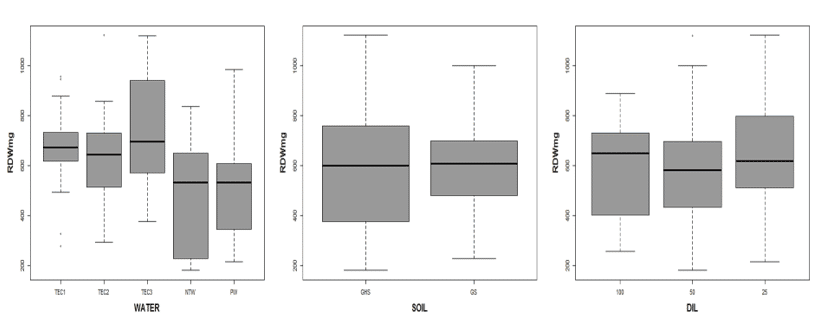
Reuse of Post-Treated Water in Irrigation Test Using a Biological Model Ryegrass Perenn
2Facultad de Ingeniería. Departamento de Ingeniería Ambiental. Universidad de La Salle., Universidad de La Salle, Colombia
3Laboratorio de Películas Delgadas y Nanofotonica. Departamento de Física. Facultad de Ciencias, Pontificia Universidad Javeriana, Colombia
Introduction
Different wastewater technologies should not only guaranty color, COD and BOD5 removal, but also they have to be capable of produced by-products less toxic that pattern compounds. Taking that into account, The aim of this study was use the post-treated effluent of a pilot plant as irrigation wáter using the biologic model Ryegrass perenn.
Experimental Design
Greenhouse re-use test
The effluent obtained after each cycle of treatment was characterized in order to establish its quality for being used as irrigation water. The grass was selected as a biologic model for greenhouse tests. A Factorial experiment with a completely randomized design was applied. The different factors were irrigation water, soil type and the mixing ratio. The effluent obtained from each treatment cycle was tested, cycle 1 (TEC1), cycle 2 (TEC2) and cycle 3 (TEC3) and also untreated wastewater. As control drinking water was evaluated (DWW). The response variable was RDW (Root Dry Weight). The Analysis of variances was performed using R statistical software in R wizard platform.
Results
FIGURE 1.

Figure 1. showed the mean and value distribution between water, soils and dilutions. The results followed a normal distribution: Test Kolmogorov-Smirnov with Lilliefors correction (p = 0.7345) and Shapiro-Wilk (p=0.8372). Variance homogeneity was also found for the three evaluated factors (p = 0.5807, 0.0536 y 0.4306). There were differences in root weight and type of water (ANOVA, F1;57 = 4.20, p= 0,0047). No differences were found either for the type of soil (ANOVA, F2;57 = 0.01, p= 0,8976) or dilution (ANOVA, F3;57 = 0.20, p= 0,8155). The results of Tuckey test showed significant differences when comparing water from Cycle 1, Cycle 3 (p= 0.06344) and potable water (p= 0.00925).
Conclusion
Finally, biomass of Lolium perenne was higher when post-treated water was used in comparison with untreated wastewater and drinking water.
Powered by Eventact EMS